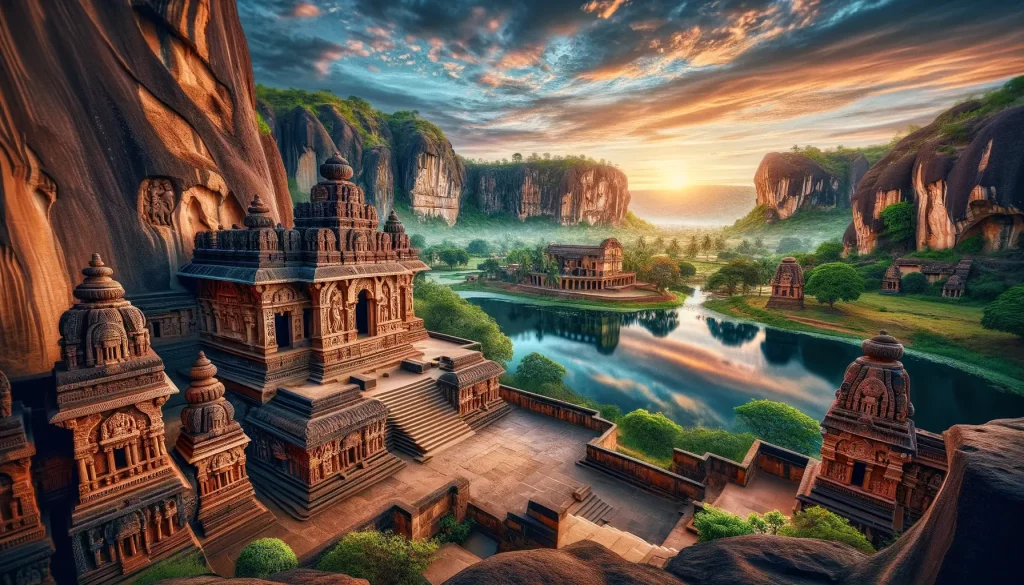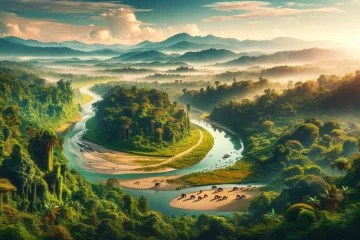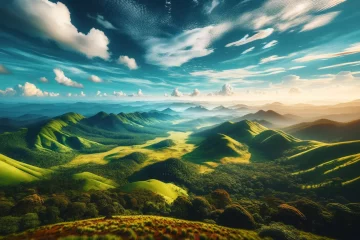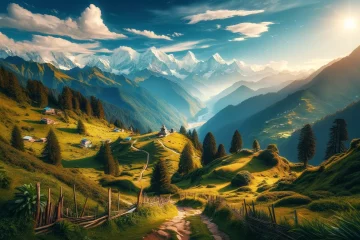Discover the Best Time to Visit Badami: A Journey Through History

Introduction
Namaste, dear readers! Today, let’s embark on a virtual journey to one of Karnataka’s hidden gems – Badami. Nestled in the Bagalkot district, this historical town is not just a destination; it’s a vivid chapter in India’s rich cultural tapestry. I’ve always been fascinated by how places like Badami are steeped in history yet remain under-explored. It’s like finding a rare book in an old library, waiting to be read!
Badami, once the regal capital of the Chalukyas, is a testament to India’s diverse architectural and cultural heritage. Its allure isn’t just in the monuments but in the stories they whisper. I remember being awestruck during my first visit, feeling like I had stepped back in time.
The Charm of Badami
- Time-Tested Architectural Marvels: The Badami Cave Temples are a sight to behold. Carved out of sandstone hills, these four caves are a confluence of Hindu, Jain, and possibly Buddhist traditions. Each time I visit, I discover something new in the intricate carvings – a testament to the Chalukyan artisans’ mastery.
- A Lake with Legends: Agastya Lake, surrounded by hills and temples, isn’t just a body of water; it’s a character in Badami’s narrative. The locals say its holy waters can cleanse sins. Whether you believe it or not, the serene view at dawn is undeniably purifying for the soul.
- The Bhutanatha Temples: Overlooking the Agastya Lake, these temples provide a picturesque frame of ancient craftsmanship meeting natural beauty. The play of light and shadow here during sunsets is a photographer’s delight – a scene that stays with you long after you’ve left.
Weather Patterns in Badami
Understanding Badami’s climate is key to enjoying what the town has to offer fully. It’s like picking the right seasoning for a dish – the timing needs to be perfect!
- Summer (March to June): Frankly, summers here can be quite scorching. I’d advise against planning a trip during this time unless you’re a fan of the intense Indian summer. However, if you do visit, the uncrowded temples offer a unique, solitary experience.
- Monsoon (July to September): This is when Badami transforms! The rains bring a refreshing change, turning the landscape lush and vibrant. But be warned, the terrain can get tricky, and some areas might be inaccessible. It’s a trade-off between beauty and convenience.
- Winter (October to February): Now, this is what I call the perfect season! The weather is cool and pleasant – ideal for exploring the town at your leisure. The crisp air and clear skies make every view picture-perfect. Trust me, winter in Badami is not just a season; it’s a celebration of its splendor.
Best Time to Visit
Deciding when to visit Badami is like choosing the perfect moment to sip a finely brewed cup of chai – timing is everything!
- October to December: These months are my personal favorite. The post-monsoon greenery is still fresh, and the weather is just right – not too hot, not too cold. It’s the ideal time for long, leisurely explorations of the caves and temples. The light is perfect for photography too!
- January to February: If you prefer cooler weather, this is your window. The chill in the air is invigorating, and the tourist crowd is thinner. It’s a period when solitude and serenity are your companions in the ancient corridors of Badami.
- March: Considered by many as the last comfortable month before the heat sets in. If you don’t mind a little warmth, March offers a unique advantage – fewer tourists and more intimate encounters with the town’s history.
Festivals and Cultural Events
Celebrating with Badami is like dancing to the rhythm of its history. The town’s festivals are as vibrant as its frescoes!
- Banashankari Temple Festival in January: Held at the Banashankari Temple, this annual fair is a kaleidoscope of culture, color, and devotion. The rath yatra (chariot procession) is a sight to behold!
- Mahashivaratri in February/March: Witness Badami transform during this festival dedicated to Lord Shiva. The temples are alive with devotion, and the air resonates with chants and hymns – an immersive cultural experience.
Travel Tips for Visitors
Navigating Badami is part of the adventure, but a few tips can make the journey smoother.
- Local Transport: Autos and hired cabs are your best bet. But, remember to negotiate the fare beforehand. If you’re adventurous, rent a bicycle – it’s an eco-friendly way to explore.
- Language Tips: A smattering of Kannada (the local language) can go a long way in making connections with the locals. Simple phrases like “Namaskara” (Hello) and “Dhanyavadagalu” (Thank you) are appreciated.
- Safety and Respect: While Badami is generally safe, usual travel caution is advised. Respect the local customs and heritage sites. Remember, you’re a guest in their historic home.
- Engage with the Locals: Don’t just be a tourist. Talk to the local vendors, the guides, the chaiwallahs. Their stories add layers to your travel experience that no guidebook can offer.
Accommodation and Dining
Finding the right place to stay and savoring the local flavors are essential parts of your Badami expedition.
- Accommodation Options: Badami offers a range of stay choices to suit every budget. From cozy guesthouses that immerse you in local culture to comfortable hotels with modern amenities, you’re spoiled for choice. Some recommended places to consider include the Clarks Inn Badami, Krishna Heritage, and the Karnataka Tourism-run Mayura Chalukya.
- Local Cuisine: Ah, the food! Don’t miss out on indulging in the local cuisine. The town’s cuisine is a delightful blend of Karnataka and North Karnataka flavors. Savor Badami’s specialities like Jolada Rotti (sorghum bread), Enne Badnekai (stuffed brinjal), and the irresistible Badami ice cream. And of course, the aromatic filter coffee is a must-try, especially at a local eatery.
- Dining Tips: Venture into the local eateries to taste the authentic flavors. Don’t hesitate to ask the staff for recommendations. They often have hidden gems that don’t make it to the tourist maps. Engaging in culinary conversations with locals can lead to gastronomic discoveries.
Nearby Attractions
While Badami is a gem in its own right, don’t forget to explore the treasures nearby.
- Aihole: Known as the ‘Cradle of Indian Architecture,’ Aihole is a short drive away. It’s a hub of ancient temples, each telling a unique story. Exploring Aihole is like stepping into a centuries-old open-air museum.
- Pattadakal: Another UNESCO World Heritage Site, Pattadakal, is nearby. It’s a breathtaking complex of temples, showcasing a blend of Chalukyan and Dravidian architecture. The intricate carvings here will leave you in awe.
- Badami Fort: Don’t forget to trek up to the Badami Fort for panoramic views of the town and its surroundings. The trek is a bit steep but well worth the effort.
In Badami and its vicinity, history and beauty are intertwined. These nearby attractions are like the bonus tracks on an already fantastic album.
Conclusion
Badami, with its mesmerizing architecture, serene landscapes, and warm locals, is more than just a travel destination. It’s a portal to India’s glorious past and a canvas for the present. Visiting Badami isn’t just about seeing; it’s about feeling, breathing, and experiencing history in every stone and every sunset.
In Badami, every season has its own melody, every temple its own story, and every meal its own flavor. As you plan your journey, remember that the best time to visit Badami ultimately depends on your preferences. Be it the vibrant festivals, the enchanting caves, or the tranquil lake, Badami welcomes you with open arms.
So, when are you packing your bags and setting off on this remarkable adventure? Feel free to share your thoughts, questions, or experiences in the comments below. Let’s continue this beautiful conversation as fellow travelers on the road to Badami!



0 Comments